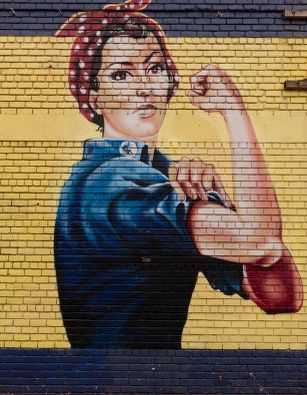Riveting Rosies
- Sally Jameson Bond

- Oct 6, 2021
- 3 min read

Just before the United States entered World War II at the end of 1941, less than 20% of women were employed outside the home, and most of those women worked as receptionists, department store clerks, or secretaries. The war certainly changed all that. With so many men signing up to serve their country, it soon became clear that factories and shipyards could not meet the extraordinary demands of the military war machine unless women became involved in almost every aspect of production.
Enter Rosie the Riveter.

The first image (seen above) to symbolize women in the workforce during World War II was created in 1942 by the American artist J. Howard Miller who was hired by the Westinghouse Corporation to produce a recruitment poster for female workers. It was very effective, but that image wasn’t identified as Rosie the Riveter until later, after an early 1943 song written by Redd Evans and John Jacob Loeb was recorded by American bandleader Kay Kyser. Not long after the hit song was released, Norman Rockwell’s drawing of a female defense worker appeared on the cover of the May 29, 1943 issue of The Saturday Evening Post. Rockwell’s subject resembled the Miller depiction to some degree—blue jumpsuit, muscular—but she also had her foot on a copy of Adolf Hitler’s Mein Kampf and her lunch box sported the name ROSIE on the front. Thus began the life of Rosie the Riveter, remaining one of the best-known icons of the Second World War.

During World War II, nearly nineteen million women held full-time jobs, and two million of those jobs were in war-related industries. Women handled heavy construction machinery, built airplanes and ships and tanks and Jeeps, worked in lumber and steel mills, in chemical, rubber, and metals factories, and assembled delicate munitions equipment. Most felt it was their patriotic duty to fill all those positions left empty by their husbands and brothers and sons and neighbors. And they wanted the results of their labors to be perfect in every respect—their husbands and brothers and sons and neighbors depended on them.
Many women who worked outside the home during the war were mothers of young children. Day care wasn’t part of the lexicon in the 1940s, so women organized, assembling into groups, sometimes sharing apartments to save money, utilities, and food. They shared chores and worked different shifts so they could take turns babysitting. They were creative—they made it work.
Rosie the Riveter was obviously a White woman, but there were also Black, Hispanic, and Asian Rosies, too, all working side by side. It was a chance for economic empowerment. Just before we entered the war, as the U.S. was ramping up the defense industry, some employers—mostly White men—refused to hire Black women. But, President Roosevelt, to his credit, signed Executive Order 8802 in June 1941, which banned racial discrimination across all war-related work. The order also established the Fair Employment Practices Commission which was tasked with enforcing the new policy.
Women of color not only worked in the manual labor force, but also as computer scientists, administrators, and railroad conductors. Employment with the YWCA and the Red Cross also provided opportunities for African American women to join the war effort. World War II did not end discrimination for our minority populations, but for a time, it provided much needed income and a feeling of purpose for thousands of hard-working women across America.
In 1944, Rosie the Riveter became the subject (and the title) of a Hollywood musical comedy starring people most of us have never heard of. (Well, Joe and I have never heard of them.) Maybe it will be the subject of a subsequent blog. (Don’t hold your breath.)
Rosie’s legacy lives on, as evidenced by these current images.
Blessings to all.
Sally Jameson Bond is retired and lives in Southwest Virginia with her husband and two dogs. My Mother’s Friend is her first novel. You can find her web site here: www.sallyjamesonbond.com.















FDR issued the executive order banning racial discrimination in war work after A Philip Randolph, President of the Brotherhood of Sleeping Car Porters Union threatened a march on Washington of 50,000 Black men. Randolph and Bayard Rustin were organizing the march, but cancelled it after FDR signed Executive Order 8802. There was some disappointment, because the order applied only to war work, not the military itself, which remained segregated. Randolph and Rustin put their planning to work in 1963, when they organized the "March on Washington" to support what became the Civil Rights Act of 1964. It was at the 1963 march where Martin King gave his "I have a Dream Speech" the only speech that could have possibly overshado…
Carl 'Alfalfa' Switzer of "Our Gang" fame is the only cast member of "Rosie the Riveter" that I recognize.